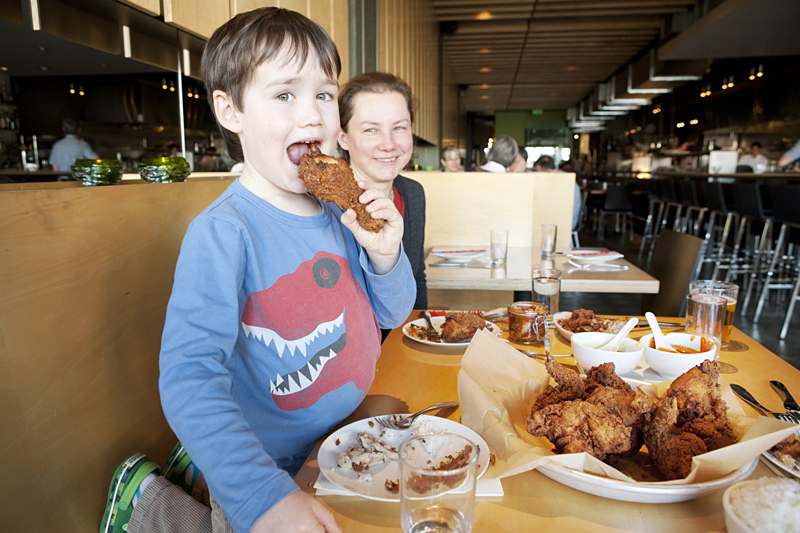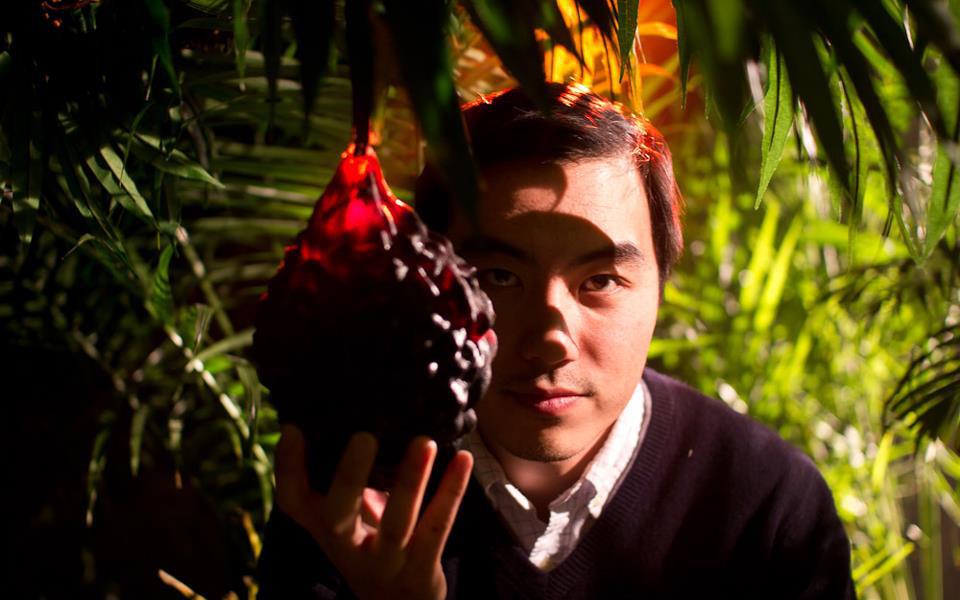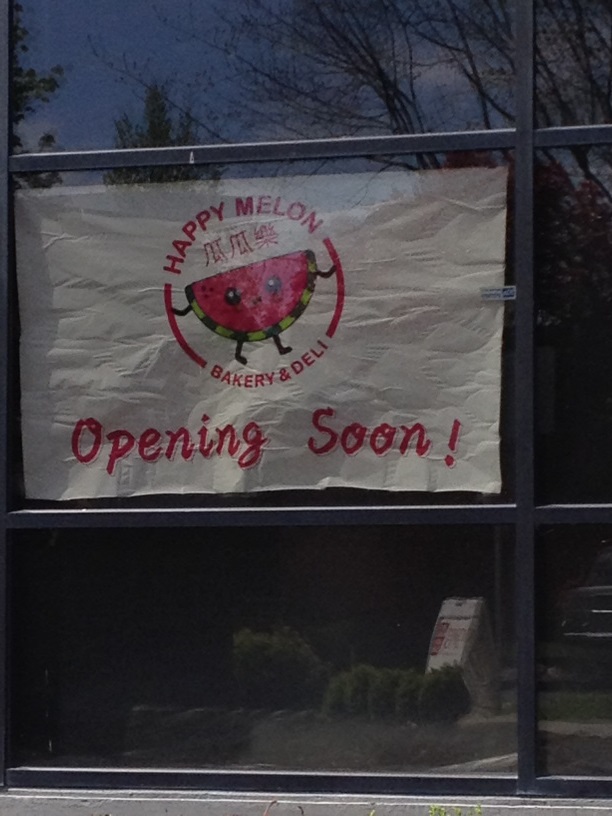True-crime stories and musical comedies were more entertaining when people could plausibly slough off their identities, drifting to another town to become a deposed crown prince after a life spent as a milkman. But social media have largely put a stop to those shape-shifting shenanigans. As college students intent on closing out painful adolescences are apt to discover, it’s a bugger to make the transition from mousy band geek to outspoken libertarian rocker when 238 of your high-school classmates are monitoring your moves on Facebook.
Technology has made everything easier—except reinvention. So it’s to chef Mark Fuller’s credit that he’s found a way to seamlessly remake Spring Hill restaurant, his lauded West Seattle fine-dining destination, as Ma’ono Fried Chicken & Whisky, a whimsical Hawaiian fried-chicken house built on a foundation of Monday-night chicken dinners so popular that customers threatened tantrums when Fuller temporarily pulled them from the schedule. “He wanted to bring a new life to Spring Hill,” says Fuller’s wife and co-owner, Marjorie Chang Fuller.
The restaurant’s look is mostly unchanged: There are a few more seats in the bar and weeknights are louder, the inevitable result of diners drinking brown liquor and eating with their hands. But the Fullers haven’t messed with the clean-lined, Danish Modern-ish interior, leaving in place the ash-blond booths and matching wall panels that were the backdrop for thousands of fancy sweetbread and gnocchi meals over the past four years. While Ma’ono is trying to trumpet its downmarket detour, the restaurant’s Hawaiian leanings, conceived as an homage to Fuller’s Kauai upbringing, are confined to the menu, which is constantly evolving as Fuller slyly brushes away Spring Hill’s fingerprints, deleting dishes that don’t precisely reflect the restaurant’s new focus on jazzed-up Pacific Rim cuisine. On a recent visit, two different iterations of the menu landed on our table—a mixup attributed to the fresh printing of a new batch—with macaroni salad added to the sides section.
Still, no matter how many times Fuller tinkers with the menu, it’s really a formality: Most Ma’ono diners come for the chicken. The restaurant recommends reserving a chicken in advance, although when we showed up on a Saturday night without prior arrangements, our server told us there were a few birds available. My advice is to not chance it, since eating something other than fried chicken at Ma’ono is tantamount to knocking back a non-alcoholic beer.
Some fried-chicken sorcerers claim deliciousness is mystically transferred to legs and breasts from a particular cast-iron pan. Other cooks pin their chicken successes on a secret seasoning blend, invariably devised by a great-great-grandmother who vigilantly hid her recipe from marauding Union troops. Fuller’s method is more straightforward: He brines the chicken in salt water for six hours, then soaks it in buttermilk for another 24. He dredges the chicken in flour tickled with spices based on a salt mix beloved by his grandmother (where there’s fried chicken, there are grandmas), coats the chicken with buttermilk and egg, and finishes the meat with a final run through the flour. He fries the chicken twice. Fried-chicken purists might take exception to Fuller’s way of frying, a sight more elaborate than preparations involving salt, pepper, and a paper bag. But what Fuller has produced is phenomenal next-day chicken.
To be clear, Ma’ono’s chicken is exceptional when it’s served hot from the kitchen, mounded atop tin trays lined with brown paper (which serves a purely decorative function beneath greaseless chicken parts). The crisp, ruddy skin puffs away from the magnificently tender flesh, like a Prussian general’s decorated chest. The batter is peppery, and the all-natural meat—slightly more wild-tasting than a typical chicken—rings with salt. Yet it’s impossible to make it through a Ma’ono meal without fantasizing about tomorrow’s lunch.
Plainly seasoned chickens aren’t always great leftover candidates. But a chicken with so much locked-in juice and a shield of brittle crunch is the stuff of picnics, and Ma’ono’s double-fried chicken is wonderful cold, especially when it’s been anointed with one of two sauces. Diners who order the “original style” are presented with chili oils and sauces for dressing up their bird, but it seems foolhardy to try to replicate what the kitchen’s already concocted. There’s a pungent hot mustard-and-honey sauce that looks pretty slathered on the chicken, but struck me as both too mustardy and too sweet, as though a child had been allowed to doodle with the jarred condiments on a Chinese-American restaurant table.
Far better is the gochujang, a salty paste of red chili and fermented soybeans, trimmed with sliced hot peppers. When fried-chicken historian John T. Edge interviewed Sam Lee, the Seoul-born businessman who in 1988 bought Pike Place Market’s Chicken Valley, Lee told him, “I tried to serve Korean spices, but that is dangerous for a businessman in America.” It’s a real sign of progress that eaters no longer fear the sweet smack of a Korean-inspired sauce, blanketing the rolling hills of Fuller’s crystalline crust.
The gochujang chicken is the ideal counterpart to the sour kimchi that’s served with every chicken; for an additional fee, diners can add shucked oysters to the jar, creating an appealing intergenerational meeting of the youngest and oldest edibles prized by food fetishists. Other side dishes worth ordering include a pool of Anson Mills grits, rich with Beecher’s Flagship cheese, and an elegant macaroni salad, dashed with slivered carrots and sliced green onions, that probably wouldn’t answer to “mac.”
Although chicken and whiskey get equal billing in the restaurant’s subtitle, whiskey doesn’t have any more to do with Ma’ono’s excellence than Paul McCartney had to do with writing “I Am the Walrus.” The whiskey list is a few drams longer than that of most restaurants—Ma’ono serves six different ryes, as well as single-barrel bourbons from Blanton’s and Four Roses—but none of the spirits are put to especially good use in cocktails. The ones I tried were thin, including an off-kilter Manhattan that was the shade of ginger ale.
There were other disappointments at Ma’ono, most of which underscored the importance of proactively claiming a chicken. A whole trout with an attractive sear was miserably bland, and a dry-aged steak surrounded by knuckles of oily chicken-fried mushrooms was cooked far beyond the requested medium-rare.
Starters that sounded fantastic on paper were less persuasive on the plate: A housemade Portuguese sausage banh mi was smeared with chicken-liver paté of an odd nutty flavor, and the sausage was burnt. The spiced ham in a quartet of tidy musubi blocks was pink and porky, but rendered dry by too much rice.
The pre-chicken situation isn’t entirely gloomy: A jaunty tuna poke had a transporting coastal flavor, and a stack of grilled kalbi beef short ribs hit its umami quota. Yet the best strategy might be to skip the first-course filler and focus on dessert. The standout is a banana cream pie that summons the sweet tropical meatiness of its starring fruit. Like the fried chicken, it is a marvel of plush and crust, and good reason to look forward to the day when Ma’ono’s metamorphosis is complete.
Price Guide
Poke $12
Musubi $4
Macaroni salad $4
Trout $19
Steak $34
Whole chicken (serves two) $38
Banana cream pie $7








